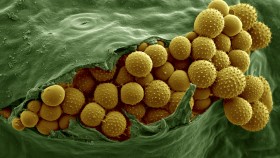Engineered micro-compartments in plant chloroplasts for food security
The low turnover rate of the CO2-fixing enzyme Rubisco in C3 crop plants is one of the major limiting factors for their photosynthetic performance and yield. Mathematical modelling shows that replacing the endogenous Rubisco with a high-turnover rate counterpart from cyanobacteria along with other components of the cyanobacterial CO2-concentrating mechanism (CCM) into the chloroplast could increase crop yield up to 60%.
Cyanobacterial CCMs consist of bicarbonate pumps located at the plasma membrane which actively increase the cytoplasmic bicarbonate concentrations, and specialised proteinaceous micro-compartments called carboxysomes that encapsulate Rubisco and carbonic anhydrase enzymes. The selective permeability of carboxysome shell allows bicarbonate to enter the lumen where it is converted into CO2 by carbonic anhydrase, but prevents CO2 leakage out of the carboxysome. This feature creates a high CO2 concentration surrounding Rubisco, enabling it to capture CO2 at a very high rate.
Dr Ben Long, Dr Wei Yih Hee and Prof. Dean Price from Research School of Biology, ANU, have successfully synthesised structural carboxysomes within the chloroplast of the model plant, tobacco, using a minimal gene set. These plant-derived carboxysomes are around 100 nm in size, which is isometric to the wild type cyanobacterial counterpart, and can be easily purified from tobacco leaves. Using transmission electron microscopy at CAM, Rubisco can be seen encapsulated in the negatively stained, purified plant carboxysomes. Plants expressing carboxysomes display delayed growth due to the requirement for additional carboxysome proteins and bicarbonate pumps, required for a fully functional CCM. However, this is a major, critical step toward creating plants with a cyanobacterial CCM.
This advance provides a platform to study carboxysome assembly for the eventual construction of functional carboxysomes in plant systems. Incorporation of a complete cyanobacterial CCM in crop plants could result in more efficient photosynthetic performance while improving both nitrogen fertilizer and water usage.








